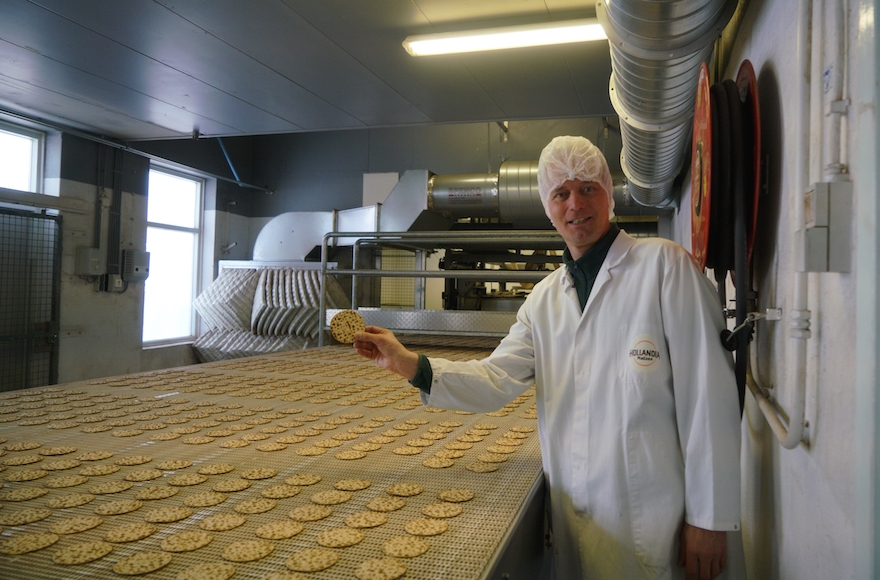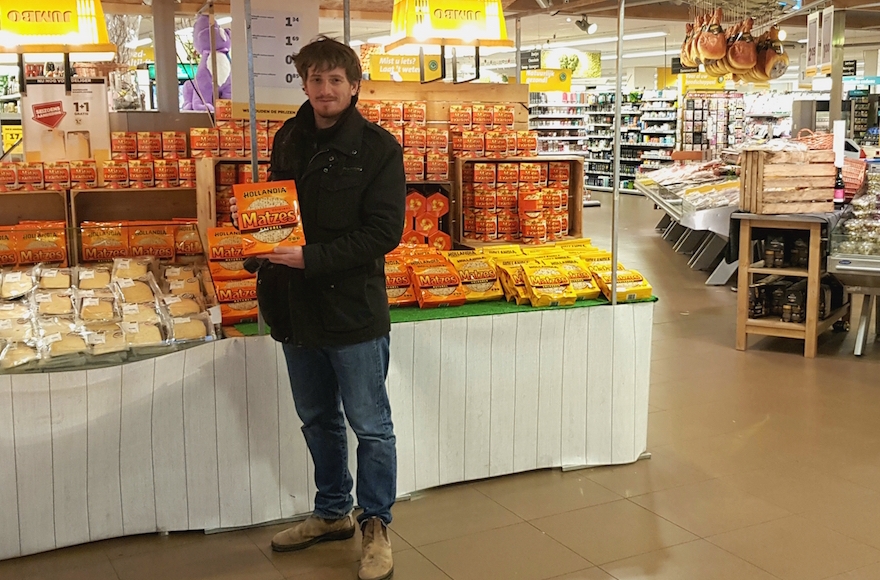How matzah became a household item for non-Jews in the Netherlands
Published March 20, 2018

Pieter Heijs shows his product at his Hollandia Matzes factory in Enschede, the Netherlands, March 19, 2018. (Cnaan Liphshiz)
ENSCHEDE, Netherlands (JTA) — For most matzah bakeries, Passover is their lifeline and only claim to financial viability.
ADVERTISEMENT
After the weeklong holiday, during which Jews are commanded to consume matzah to commemorate their ancestors’ hurried flight out of Egypt, demand for the famously tasteless cracker drops sharply.
Except, that is, in the Netherlands.
A centuries-old and proud Jewish community here has made matzah a household product that is sold in supermarkets and consumed year-round by millions of non-Jews who swear by it as their breakfast bread of choice.
That’s one reason why Pieter Heijs, a co-owner of Hollandia Matzes in this eastern city, is probably the only matzah maker in the world who braces for losses, not earnings, during Passover.
Almost all the profits of his matzah bakery — the only one in Holland — comes from sales to non-Jews of a product that lacks the “kosher for Passover” certification. However, for four weeks ahead of Passover, Hollandia also produces kosher-for-Passover matzah, which “costs more to make than what we get for it,” Heijs said.
The factory, which produces about 40 million matzah crackers annually, also makes small amounts of shmurah matzah — a specialty variant that is even costlier because of its stringent adherence to the kosher rules. To prevent even the hint of leavening, the wheat and flour never come into contact with moisture from the time of the harvesting until the dough is kneaded and the sheets are baked.
Still, Heijs remains committed to making matzah that is kosher for Passover.
“It’s a matter of tradition, and it means a great deal to me,” said Heijs, who is not Jewish. “Even if it comes at the expense of our profit margins, we will continue to produce Passover kosher matzah for as long as we can.”
ADVERTISEMENT
The losses, however, are dwarfed by the boom in Hollandia’s sales during Easter, which often coincides with Passover. On the Christian holiday, millions of Dutch buy and eat matzah as part of a nationwide tradition that testifies to centuries of Jewish influence on the general population.
A liberal nation that was home to one of Europe’s most illustrious Jewish communities before its near annihilation by the Nazis and their collaborators during the Holocaust, the Netherlands has other examples of interfaith borrowings (take the oliebol, a deep-fried winter snack in Holland that many trace back to the Hanukkah doughnut called sufganiyah).

A shopper browsing for matzah at the Amsterdam Noord branch of the Jumbo supermarket chain, March 17, 2018. (Cnaan Liphshiz)
Such carryovers were perhaps possible in the Netherlands partly because many Protestant Christians here emphasize the Hebrew Bible over the New Testament. But Heijs said “it’s because Dutch Jews were so integrated into the fabric of society.”
The matzah became a year-round household food in recent decades as supermarkets replaced smaller grocery stores, according to Jonah Freud. He published a book in 2012 about the Dutch Jewish cuisine based on her research for the Jewish Historical Museum of Amsterdam.
“I think it may be connected to how matzah is perceived as healthy,” Freud said.
Heijs concurs.
“Many of our clients want matzah because it’s such a pure product,” he said. “No additives, no conservatives, highly nutritious. What more can you ask of a health food?”
In an overture to the health-food crowd, one of the first moves by Heijs and his business partner, Udo Karsemeijer, who also is not Jewish, after they bought Hollandia in 2004 was to add an organic matzah product to the lineup. It includes matzahs in two sizes, a whole wheat variety and one with spice herbs.
Hollandia now exports products to Scandinavia, Germany and even France, where several matzah bakeries compete for a market with 500,000 Jews.
Heijs and Karsemeijer bought the Hollandia factory from a Jewish family named Woudstra. The founding family built the factory in Enschede because it had a large Jewish community, and because of the arrival to the eastern Netherlands of thousands of Jews who fled the Nazis in nearby Germany.
When the Nazis invaded in 1940, the Woudstras went into hiding and the Nazis closed down Hollandia.
Before the invasion, the Netherlands had several matzah bakeries, according to the Dutch Bakers’ Museum. Among the best known and oldest was the De Haan bakery in the picturesque fishing village of Marken, north of Amsterdam. It operated only ahead of Passover, and after the baking of the last matzah each year, De Haan employees would march to music through the village dressed in white sheets and ceremoniously extinguish the ovens.
One of the production line machines inside Hollandia, a state-of-the-art factory with 18 employees who work year-round inside a three-story building, dates back to 1924. Inside the room where it now operates, the local Jewish community briefly ran a Jewish school for the children who were expelled from the general education system under the Nazis.
The factory reopened after World War II, during which the Germans killed 75 percent of the prewar Dutch Jewish population of 100,000. The community never replenished its numbers.

Heijs displays a box of his matzah at his factory, March 19, 2018. (Cnaan Liphshiz)
By then, however, matzahs had developed a non-Jewish following.
The eye-catching and instantly recognizable packaging of Hollandia matzah boxes — an orange-colored octagonal cardboard box with a nifty camera-aperture opening – was a marketing coup cooked up by the Woudstras, Heijs said.
The matzah became even better known to the Dutch immediately after the war because the Hollandia factory received generous subsidies under the Marshall Plan for financial aid to rebuild war-torn Europe, according to Heijs.
He said the funding was meant also as a gesture acknowledging Jewish suffering during the Holocaust.
“But it was also a practical decision: Matzah requires no eggs, no salt, no sugar – all commodities that were in very short supply immediately after the war,” Heijs said. Whatever the reason, he added, the reality was that Hollandia was “one of the first bakeries that were restored” after the war, thus entrenching its status as a household brand.
Heijs, 55, remembers enjoying Hollandia matzah as a boy ahead of and also directly after Easter.
“I understand that matzah is not considered a delicacy exactly among Jews, who substitute bread for matzah for [eight days] each year,” he said. “But for us, who had it in addition to everything else, it was a treat that went very well with chocolate and butter.”
Karina Ahles-Frijters, who lives in Hilversum, near Amsterdam, wrote in 2016 on her parenting blog Trotsemoeders that her three children like to experiment with matzah toppings (her eldest prefers whole wheat matzah with butter and sugar-coated anise seeds, she wrote). One day a year, the Hollandia factory is open to anyone interested in making their own matzahs.
But not everyone is a fan of the matzah.
“Frankly I couldn’t tell you why so many Dutchmen like matzah — I don’t think it’s tasty at all,” said Roger van Oordt, the director of the Netherlands-based Christians for Israel group, which organizes matzah-baking activities in solidarity with Israel and the Jews. “If I have to think about eating nothing but matzah for two weeks, it makes being Christian look easy.”
Although he is not Jewish, Heijs regards matzah as much more than a commodity.
“After 14 years of making matzahs, of course I developed friendships and bonds with many Jewish people,” said Heijs, who on Passover eve this year will attend his first seder dinner with his wife at the invitation of a Dutch Jewish community in northern Holland. “But matzah is part of the Dutch story regardless.”














